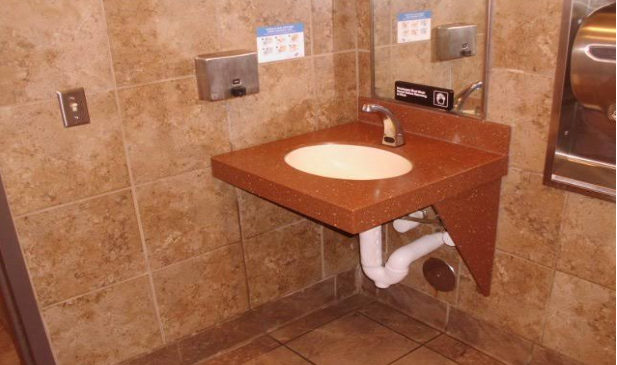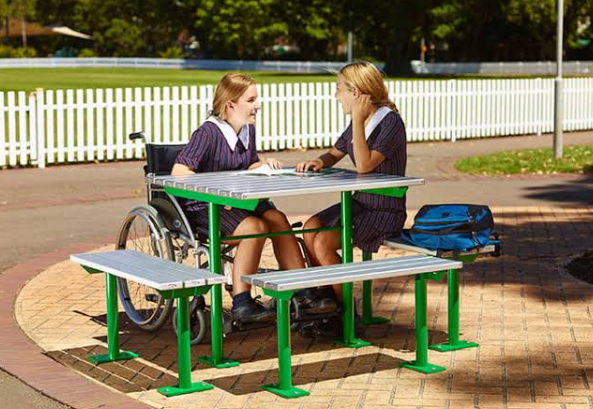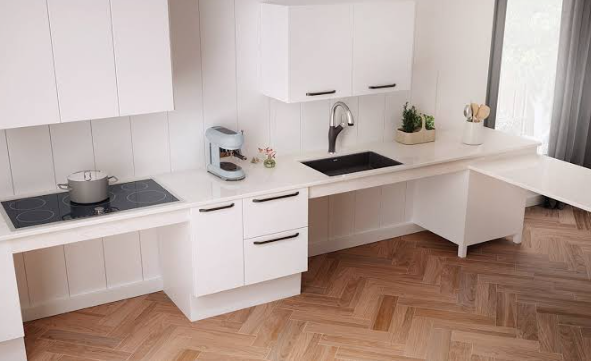

Knee clearance is one of those little design details that makes a big difference in how comfortable and accessible public space feels. In places like libraries, parks and restaurants, well-designed furniture allows people including those with disabilities to use these spaces comfortably and without frustration. Knee clearance, and the open space beneath tables, counters, and other fixtures are very important in ensuring accessibility. Here’s why it matters and how it affects the overall experience of public spaces.
Knee clearance is the space under tables, counters, desks and other similar fixtures that allows room for a person’s knees when seated. According to the ADA standards, knee clearance should be at least 27 inches from the floor to accommodate wheelchair users comfortably. This space is not just about ensuring legs fit under a surface, it also makes sure people have enough space to reach and interact with whatever is on the surface.
When there’s not enough knee clearance, it creates barriers for people who use wheelchairs, crutches or with limited mobility. Imagine trying to eat at a picnic table but discovering that your knees can’t fit under it. You’d be forced to sit at an uncomfortable distance, which could make it difficult or impossible for you to even eat. Unfortunately, many people experience this in public spaces because the furniture is not designed with accessibility in mind.
Proper knee clearance, however, allows everyone including those with disabilities to comfortably use public furniture. When tables and counters meet ADA standards, they invite all people to use them without feeling excluded or uncomfortable.
One major impact of poor knee clearance is on accessibility. Public spaces are meant to be accessible, but when furniture lacks adequate knee clearance, people who use wheelchairs or other mobility aids may feel left out or unable to participate fully. For example, a high countertop in a coffee shop with no knee clearance makes it impossible for a wheelchair user to sit comfortably while ordering or enjoying a drink. This issue isn’t just inconvenient, it’s isolating.
Also, ADA compliance is required for public spaces, so ensuring adequate knee clearance is a legal necessity.
Incorporating knee clearance into public furniture design is important. Designers and architects need to think about how knee clearance ADA will help people interact more with the space, and ensure that tables, counters and benches are accessible. Solutions don’t have to be costly; small adjustments in height and positioning can make a big difference.

Knee clearance might seem like it’s not a big deal, but it has a significant impact on how people use and access public spaces. When public furniture is designed with adequate knee clearance, it not only complies with ADA standards but also creates a welcoming environment where everyone can feel comfortable and accepted.

When considering the safety and accessibility of all users in a restroom, sink clearance plays a crucial role. The amount of space around a sink

Building an ADA-compliant kitchen doesn’t have to involve a full renovation. With a few adjustments, you can ensure ADA clearance in your kitchen and make

Knee clearance is one of those little design details that makes a big difference in how comfortable and accessible public space feels. In places like libraries, parks and restaurants, well-designed furniture allows people including those with disabilities to use these spaces comfortably and without frustration. Knee clearance, and the open space beneath tables, counters, and other fixtures are very important in ensuring accessibility. Here’s why it matters and how it affects the overall experience of public spaces.
Knee clearance is the space under tables, counters, desks and other similar fixtures that allows room for a person’s knees when seated. According to the ADA standards, knee clearance should be at least 27 inches from the floor to accommodate wheelchair users comfortably. This space is not just about ensuring legs fit under a surface, it also makes sure people have enough space to reach and interact with whatever is on the surface.
When there’s not enough knee clearance, it creates barriers for people who use wheelchairs, crutches or with limited mobility. Imagine trying to eat at a picnic table but discovering that your knees can’t fit under it. You’d be forced to sit at an uncomfortable distance, which could make it difficult or impossible for you to even eat. Unfortunately, many people experience this in public spaces because the furniture is not designed with accessibility in mind.
Proper knee clearance, however, allows everyone including those with disabilities to comfortably use public furniture. When tables and counters meet ADA standards, they invite all people to use them without feeling excluded or uncomfortable.
One major impact of poor knee clearance is on accessibility. Public spaces are meant to be accessible, but when furniture lacks adequate knee clearance, people who use wheelchairs or other mobility aids may feel left out or unable to participate fully. For example, a high countertop in a coffee shop with no knee clearance makes it impossible for a wheelchair user to sit comfortably while ordering or enjoying a drink. This issue isn’t just inconvenient, it’s isolating.
Also, ADA compliance is required for public spaces, so ensuring adequate knee clearance is a legal necessity.
Incorporating knee clearance into public furniture design is important. Designers and architects need to think about how knee clearance ADA will help people interact more with the space, and ensure that tables, counters and benches are accessible. Solutions don’t have to be costly; small adjustments in height and positioning can make a big difference.

Knee clearance might seem like it’s not a big deal, but it has a significant impact on how people use and access public spaces. When public furniture is designed with adequate knee clearance, it not only complies with ADA standards but also creates a welcoming environment where everyone can feel comfortable and accepted.